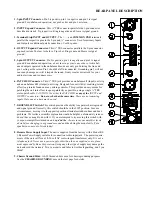
All features & specifications subject to change without notice. 520-109 AUG94
Printed in the U.S.A. on Recycled Paper
©Rane Corporation 10802 47th Avenue West, Mukilteo WA 98275-5098 TEL(206) 355-6000 FAX(206) 347-7757
IMPORTANT NOTE
OPERATING INSTRUCTIONS
Before attempting any equalization of audio with the FPE
13, it is important to optimize the Input GAIN control setting.
Improper gain distribution is a common cause of headroom
loss in audio systems.
The FPE 13 provides you with an overall BYPASS switch
& indicator as well as an OL (overload) LED as useful tools
for optimizing gain set-up. The BYPASS switch is most
useful for making A-B comparisons, i.e., comparing equal-
ized (Bypass
out
) versus unequalized (Bypass
in
) sound. To
be able to do this freely, without danger of system damage,
requires you to set the level through the FPE 13 to approxi-
mately unity. Failure to do so can produce alarming results.
The gain range of the FPE 13 goes all the way from Off to
+20dB. Quite respectable—and enough rope to hang yourself.
Since the FPE 13 is always unity gain in Bypass, if you add or
reduce Gain (beyond EQ make-up gain) the level differences
between Bypass in/out can be startling. Therefore you want to
set the GAIN control for equal in/out loudness levels.
To get started, make these initial set-up adjustments:
BYPASS Switch “
In
” (= bypassed condition = red LED
on
).
GAIN Control Center-Detent Position (unity gain spot).
(3) LEVEL Controls Center-Detent Positions (0dB boost/cut).
Next apply a signal to the system. Their will be no system
gain change because the FPE 13 is in Bypass. Check the OL
indicator to be sure it is not lit. If the OL LED is on, turn
down the GAIN control until it goes out. Note, however, that
the FPE 13 will no longer have unity gain when you switch it
out of Bypass.
If the OL LED is not lit, then the center detent position of
the GAIN control is the ideal place to start. Do not increase
the gain above this point until you do enough cutting with the
EQ controls to warrant adding make-up gain. Use the BY-
PASS switch to set equal loudness.
Release the BYPASS switch and you are ready to start
equalizing the system. And since feedback and tone contour-
ing are two of the most common uses for equalization, here
are a few words on each.
FEEDBACK
may be controlled nicely with a device such
as the FPE 13. With the range switches you may position all
three bands of the equalizer to overlap to remove any acoustic
resonances causing you grief. As luck would have it, the top
few nodes are usually grouped in such a way that you can’t
get them all with a conventional parametric. With the FPE
13’s overlapping bands, you never have this problem.
A good way to find them is to set the bandwidth for about
1/2-octave, the LEVEL control to full cut, then sweep around
with the FREQuency knob until you find the first culprit.
Once you center on the ring frequency, reduce the amount of
cut to a level just below where the feedback comes back.
Then reduce the BandWidth to a point where the feedback
stays dead and the sound quality comes back to life. Some-
thing between 1/30 octave and 1/3 octave usually does the
trick.
TONE CONTOURING
is accomplished with the FPE 13
mainly by ear. This you know how to do. Be careful, though,
not to introduce too much boost to the upper bass area to
prevent your audience from calling 911. Be aware also that
the FPE 13 is capable of boosting signals up to +15dB—a
level at which great care should be taken to prevent seismic
disturbances.
Happy EQing and have fun.
CHASSIS GROUNDING
The FPE 13 is supplied with a rear-mounted ground-
lift switch. The unit is shipped with this switch in the
“grounded” position, tying circuit ground to chassis
ground. If after hooking up your system it exhibits
excessive hum or buzzing, there is an incompatibility in
the grounding configuration between units somewhere.
Your mission, should you accept it, is to discover how
your particular system wants to be grounded. Here are
some things to try:
1. Try combinations of lifting grounds on units that
are supplied with ground lift switches or links.
2. If your equipment is in a rack, verify that all chassis
are tied to a good earth ground, either through the line
cord grounding pin or the rack screws to another
grounded chassis.
3. Units with outboard power supplies, such as the
FPE 13, do not ground the chassis through the line cord.
Make sure that these units are grounded either to another
chassis which is earth grounded, or directly to the ground-
ing screw on an AC outlet cover by means of a wire
connected to a screw on the chassis with a star washer to
guarantee proper contact.
Please refer to Rane Note 110 (supplied with your FPE
13 and available on request at no charge if you lost your
first one) for further information on system grounding.






















